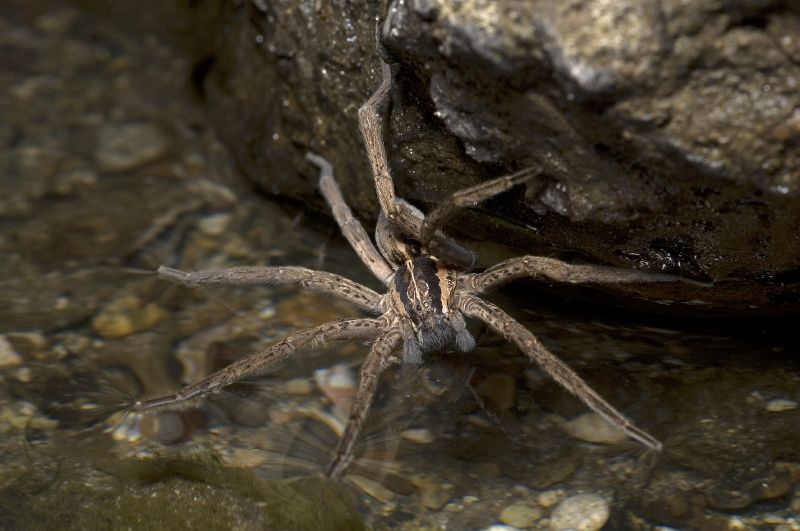- Fishing spiders of New Zealand
Taxobox
name = "Dolomedes"

image_width = 240px
image_caption = "D. minor" female feeling the water for prey
regnum =Animal ia
phylum =Arthropod a
classis =Arachnid a
ordo = Araneae
familia = Pisauridae
genus = "Dolomedes"
genus_authority = Latreille, 1804
diversity_link = List of Pisauridae species#Dolomedes
diversity = c. 100 species
subdivision_ranks = New Zealand species
subdivision ="D. aquaticus"
"D. minor"
"Dolomedes III "
"Chatham Islands Dolomedes"The fishing spiders of New Zealand include at least four relatively common species of "Dolomedes " spiders adapted to take advantage of the abundant food supplies thatriver banks provide. Rather than wait on land forinsect s to happen by, these spiders hunt on the water surface itself, preying on mayflies and other aquatic insects. For fishing spiders, the water surface serves the same function as a web. They extend their legs onto the surface, feeling for vibrations given off by struggling insects.Species
Two of the fishing spiders are widespread on the two main islands of New Zealand. "
Dolomedes aquaticus " grows up to 7 cm across and specialises in open, unforested riverbanks, and lives under rocks within 5 metres of the river. Another species of similar size, specialising in forested riverbanks, is also widespread on the mainland, but is as yet undescribed. It is known as "Dolomedes III " or the New Zealand Forest Fishing Spider. The largest of the New Zealand fishing "Dolomedes" spiders occurs in theChatham Islands , but has not yet been named. The fourth species, "D. minor", is not restricted to rivers. Known as the Nursery Web Spider, it makes white nursery webs on shrubs, but is still capable of fishing behaviour.New Zealand "Dolomedes" species have yellow stripes on each side of their head (
cephalothorax ), but their overall colouring is adapted to conceal them in their chosen environment. "D. aquaticus" is the dark grey of thegreywacke rocks that line many New Zealand rivers, while "D. III" has a mottled pattern to match its forest home.Underwater, the fishing spiders can remain submerged and able to breathe from the air bubbles trapped in their body hairs by means of a organ underneath their abdomens called a
book lung . The trapped bubbles make the spiders buoyant and they must hold onto a rock or a plant stem to stop floating to the surface and popping through, completely dry.Hunting behaviour
) on their legs and feet. Their eyes play a secondary role - experiments on related species show that touch is the main sense these spiders need to catch their play. Their eyes are of little use in their nocturnal hunting. These vibration detectors also serve to help the spiders avoid becoming food for predators such as trout.
As soon as the vibrations reveal that there is a floundering insect within range, some fishing spiders may take direct action - they run at pace across the surface of the water and grab the insect before it extracts itself from the water and flies to safety. Some fishing spiders, including "Dolomedes III" use silk draglines to prevent themselves from speeding past the prey. Special water-repelling (hydrophobic) hairs on their bodies enable the spiders to walk on water - an ability helped by their light weight of usually less than a gram. Walking on water is not unusual in itself, but fishing spiders are thought to be the only New Zealand species that use this ability as part of their normal hunting technique.
Michelle Greenwood fed a large moth to a small juvenile fishing spider and observed its behaviour: "On my first fieldtrip I discovered the fun of hand feeding them. I caught a large moth and offered it, truggling in my fingers, to a relatively small juvenile fishing spider. The spider daintily took it, moved itself to dry land and proceeded to eat. I watched this process for almost half an hour; fascinated by the way the spider stood on the tips of its articulated legs and deftly manoeuvred the moth with its mouthparts. She then delicately cleaned all her legs, passing each between her fangs; carefully scraping them clean before wiping each front leg over her eyes." The spider then returned to the riverside to await further victims.
Fishing spiders main prey is aquatic insects, but they are opportunistic feeders and will eat anything suitable that happens within range. Related species in North America have been observed catching and eating goldfish. [Greenwood 2008:71]
Predators
family that stings the spider to paralyse it before carrying it off and laying an egg in its abdomen. The larvae of the wasp hatch and proceed to eat the spider from the inside out. One escape technique the spiders use is to disappear beneath the surface tension of the water. However some wasps counter the disappearing trick by going into the water to sting the spider and drag them out of the water.
The North American species "D. triton" has been observed jumping to get away from an attacking frog. The researchers concluded that the spider's vibration-detecting hairs felt the rush of air as the frog lunged to attack.
Dangerous mating
Female fishing spiders are larger than the males. If a female chooses to eat a male after mating, there is usually little he can do about it. This behaviour may help the female by providing the nutrition she needs to produce healthy young, while the male gets the benefit of passing his genes on to the next generation. Some males fall victim to females that pretend to interested in sex when all they want is an easy and nutritious meal.
Notes
References
* Greenwood, Michelle, 2008. Aquatic Assassins: The Secret Life of Fishing Spiders. "New Zealand Geographic", Issue 91. See also this [http://www.nzgeographic.com/articles.php?ID=241 online summary] of the article.
* [http://www.tepapa.govt.nz/TePapa/English/CollectionsAndResearch/CollectionAreas/NaturalEnvironment/InsectsSpidersAndSimilar/SpidersWeb/What/NurseryWeb.htm Nursery Web Spiders from Museum of New Zealand Te Papa Tongarewa Website, July 2008]
Wikimedia Foundation. 2010.
